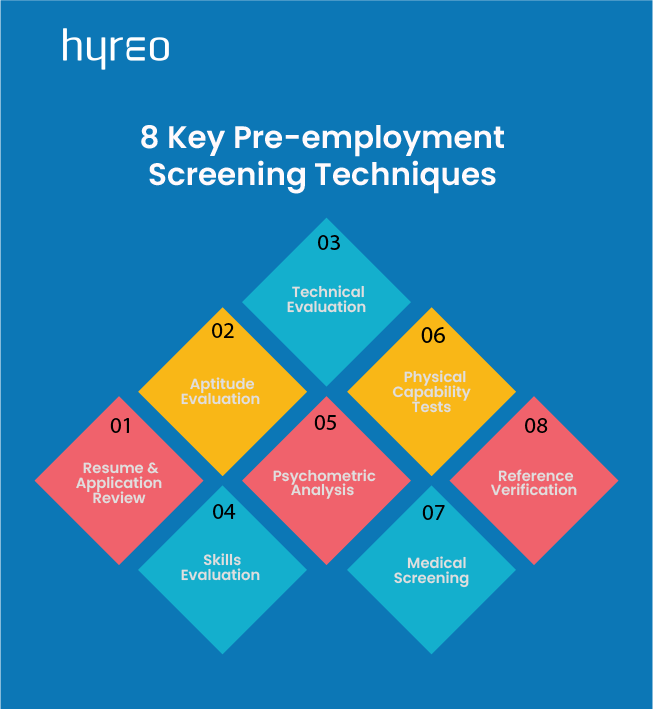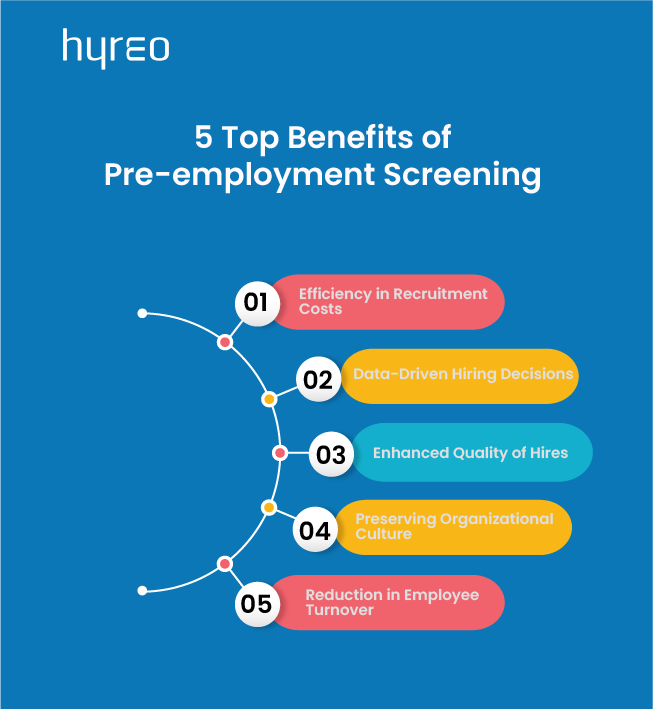“I should have known better” is possibly a statement that will cost recruiters (and organizations) dearly. It is said that the cost of a wrong hire is over 30% of the employee’s salary. Of course, the losses extend beyond the finances – effort and time invested in training and coaching, the impact on organizational productivity and culture, and many other minute aspects that adversely impact the company.
If all of this sounds serious to you, it is prudent to invest in a more thorough evaluation of the candidate before offering them employment. This can be done through pre-employment screening and assessment.
What is pre-employment screening?
Pre-employment screening is a method to verify a potential candidate’s authenticity and fit for a job role and the organization. As the term suggests, these verifications and evaluations are done before presenting the offer letter to a potential candidate.
During the formative years of pre-employment screening, the focus was to check if the information provided by the candidate on their bio-data or resume was authentic. Some standard parameters that were checked were:
– demographic details like age, address, etc.
– educational qualifications
– professional certifications
– work experience
– criminal history or breach of the law
– drug abuse or medical conditions (especially for physically strenuous jobs to avoid any legal risks)
Beyond this was the assessment of the ‘fit’ with the job role and the organizational culture. Earlier, these used to be evaluated in a face-to-face interview. Times have changed, and technology has come to our rescue, making this evaluation faster, easier and more objective.
Many automated, interactive tests evaluate a candidate on technical knowledge and skills, functional skills, and attributes that matter to the culture of the company.
Several organizations also consider personality traits like emotional intelligence and integrity while hiring.
Pre-employment screening spans right from reviewing the candidate’s application right to hiring the candidate.
8 pre-employment screening methods
There are various pre-employment tools and methods available for recruiters. Some are automated, which saves time and effort but needs some financial investment. Other methods can be implemented manually; these are cost-effective but need you to invest time and planned effort.

#1 Application and Resume Screening
This is the first phase of screening to check if a candidate meets the essential criteria for a role.
These ‘make or break’ criteria can be:
– education
– certification
– experience
– certain technical knowledge
Some roles also have demographics as their elimination criteria, like age, gender, or even location. For example, construction jobs usually prefer men since the job is physically strenuous. Or if the role includes rotational shifts or longer working hours, candidates living closer would be preferred.
Many automated tools, such as Applicant Tracking Systems (ATS) or Talent Acquisition Software (TAS), make this process effortless through a process called resume parsing. The keywords defined by the organization are matched with the candidate’s resume and sorted according to relevance.
This process can be done manually as well, but it can be very tiring for bulk hiring.
#2 Aptitude tests
Aptitude is the natural ability of a person to perform certain tasks. While specialized roles need specific aptitude (creativity for web designers), many skills are mandatory for all roles.
Some common aspects evaluated through an aptitude test are:
– verbal ability and language proficiency
– basic numerical skills
– logical reasoning
– speed and accuracy
Aptitude tests can be conducted online or as paper-pencil tests. They are usually timed tests with multiple-choice questions. Although no one can ‘fail’ an aptitude test, the application may be rejected if the scores don’t meet the set benchmark.
Some organizations ask candidates to take these tests at home, and the scores of the test determine whether the candidate is selected for further rounds of interviews.
#3 Technical knowledge and skill assessment
The evaluation of technical knowledge and skill can be divided into 3 categories:
- Basic knowledge is checked for all candidates and especially for freshers
- An intermediate level of knowledge and skill is expected and checked for experienced professionals for common job roles
- Advanced knowledge and subject matter expertise are checked for specialized or niche roles
There are several ways of evaluating this aspect:
- paper-pencil tests (evaluated manually)
- online tests, usually with multiple-choice questions
- take-home tests or assignments (evaluated later by Subject Matter Experts)
- case studies
- simulations
- code-writing or troubleshooting
- personal interview (in person or video)
#4 Skill assessment
Every job role needs the candidate to have a certain skill set – to perform the assigned tasks well and on time. These skills are called functional skills. Some common functional skills are communication, time management, planning, analytical skills, etc.
Many roles may require the candidate to interact with others. These are called interpersonal skills and are commonly noticed in customer-centric roles. Some common interpersonal skills are communication, empathy, assertiveness, etc.
Skills can be evaluated through the following methods:
1. Video resumes
2. Video assignments (candidates are asked to record video responses to standard questions)
3. Situational Judgment Tests
4. In-tray exercises (to evaluate time management and organizing skills)
5. Assessment centers (a series of individual and group activities)
6. Case studies
7. Group discussions or activities
These can also be further evaluated in personal interviews.
#5 Psychometric tests
The term ‘psychometric’ translates to measuring the mind. The personality traits, beliefs, and values of a candidate are intangible and difficult to evaluate.
Psychometric tests give you an insight into a candidate’s personality. Several standardized psychometric tests are available. Most of them have a built-in lie detector to determine if the candidate is giving socially desirable responses.
Some of them are:
– Integrity tests contain a series of statements that ask the candidate to agree or disagree with the statement on a rating scale.
– Personality tests give you an insight into some pre-specified traits of a candidate like extroversion or introversion, response to relationships and situations, etc. Some common and standardized personality tests are Myers-Briggs Type Indicator (MBTI), 16 Personality Factors (16 PF), and Big Five Personality Test.
– Emotional Intelligence tests are a fairly recent aspect that is evaluated in candidates who apply for leadership positions or roles that have high levels of people interaction. Many organizations use the results of these tests as their ‘make-or-break’ criteria for culture fit. These tests evaluate a person’s natural ability to be self-aware and change, as well as empathize and have harmonious relationships with others.
– Value mapping tests help you evaluate the candidate’s value system and understand how they can fit into the organization. Values can match the organization’s vision and values or complement them. These may not be a deciding criterion but will definitely help you place the candidate in teams or positions where they can be at their productive best.
#6 Physical Ability Test
Physical ability tests gauge the ability of a candidate to perform physical tasks. These are useful for roles that have a high amount of physical activity or spurts of high-intensity work like lab work or traveling to meet clients. Medical tests may be included in this type of test too.
#7 Medical Test
Medical tests evaluate the overall fitness of a candidate to work in a setup. It includes blood sugar tests, urine routine, and microscopy, ECG, chest x-ray, etc. This helps to get a baseline health record of the employee (also for company insurance purposes). Medical tests also include screening for drugs and substance use. These can also help the hiring managers predict productivity and the probability of availing leave.
#8 Reference Check
Background/ reference checks are about verifying information about the candidate from their previous employers and/or their schools or universities. Reference checks often give you great insight about the candidate so that you can not only make the right hiring decision but also set the right expectations with the candidate.
5 advantages of pre-employment screening
One of the reasons, pre-employment screening is so popular is because of the advantages it provides:

#1 It helps you save time and money
We know that recruitment is an investment at many levels and adds to the bottom line of the company, especially if the hires are not productive enough. Thus, a thorough pre-employment screening will help you save time and effort in re-training or re-hiring. It will also save other indirect costs of extensive training, losses caused due to mistakes at work, loss of customers or goodwill as a brand as well as an employer.
#2 It helps you make objective hiring decisions
Gathering enough information and gaining insights into the candidate helps you make data-driven and objective (also confident) hiring decisions. With the extensive range of tests available today, you can evaluate the candidate at various levels to gauge if the candidate matches the job role and the organizational culture.
#3 It improves the quality of hires
When you systematically evaluate potential candidates for the expected set of skills and values, you can choose the best talent for your company. Through the various evaluation checkpoints and set benchmarks, you can almost guarantee a higher quality of hires.
#4 It maintains a healthy organizational culture
Pre-employment assessment for culture fit ensures the hiring of candidates who are aligned with your organizational values, thereby improving the cohesion in the workforce and maintaining a good culture. It also influences the safety of the workplace due to the compliance of employees with organizational policies.
#5 It helps decrease employee turnover
This is slightly unreliable since you may not be able to predict whether and when an employee will leave the organization. However, screening for stability, aspirations and motivators of the employee will help you offer satisfactory compensation, benefits and work satisfaction. This will at least increase the tenure of an employee in the organization.
Best practices of pre-employment screening
#1 Be thorough
“If you don’t have time to do it right, when will you have time to do it over?” said the famous basketball coach, John Wooden. Considering you are investing your time, money and effort in screening a candidate, you may as well do a thorough job. This will probably increase the time-to-hire but will also increase the quality of the hire.
#2 Outsource, if necessary, but to the right vendors
Many organizations prefer to outsource basic background checks to third parties. While you do this, be mindful of associating with vendors, who understand your company’s values, needs and expectations.
#3 Know your evaluation criteria
Use tests that give you usable outcomes and not just because psychometric tests or other tests are in vogue. This needs you to be extremely clear about the skills and values that you expect from a prospective candidate.
#4 Use tests as per the stage of recruitment
Be prudent about using tests to filter candidates at every stage of recruitment. For example, aptitude tests are used to filter candidates at the beginning of the hiring process. Personality tests come into play after the candidate has met your technical expectations.
#5 Feel free to share feedback with the candidate, based on your screening
If you find that some aspects are slightly different from your expectations like the level of technical expertise, let the candidate know. You could also give them the benefit of doubt or another chance to prepare better for another interview or the next round. Other feedback such as value mismatch can also be clarified or verified with the candidate in the subsequent round of interviews.
Sum up
Depending on your hiring processes and quantity, pre-employment screening can help you reduce redundant work and improve the efficiency of your recruitment. The basic background checks will not only help you choose candidates that help your organization to be successful but also safeguard the organizational culture from declining.
The biggest advantage of pre-employment screening can be stated in a simple sentence cited by Aristotle, “Well begun is half done”.
It is wise for recruiters to invest in pre-employment screening to make their recruitment process, both effective and efficient!
FAQs on Pre-employment Screening
How can recruiters check if a prospective candidate has a criminal history?
Recruiters may directly not have access to such information. However, they can outsource this activity to third-party vendors who will get this verified for you.
What should a recruiter do when a candidate’s background check is negative?
When a candidate’s background check fails, they must be informed that their candidature will not be considered. There is no obligation for the employer to disclose the specific reason. However, if you feel the candidate must not reapply to the organization, you must communicate so.




